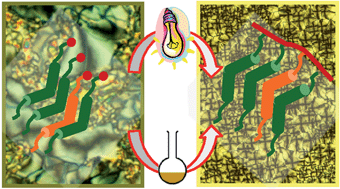Bent-core liquid crystal phases promoted by azo-containing molecules: from monomers to side-chain polymers†
Abstract
New bent-core monomethacrylates and their side-chain polymers containing the 3,4′-biphenylene moiety as a central core and both all-ester and azo-ester lateral structures have been prepared and characterized. Attractive results concerning the scarcely studied side-chain homo- and copolymers, synthesized either by in situ polymerization in the mesophase or ATRP in solution, are reported. The research is focused on the synthesis of these materials and the effect that structural changes, such as the number of aromatic rings (5 or 6), the presence of –N![[double bond, length as m-dash]](https://www.rsc.org/images/entities/char_e001.gif) N– versus –COO– links on the lateral structures, and the relative positions of the reactive groups, have on the liquid crystal properties of these new bent-core based-materials. The mesomorphic behavior of these low and high-molecular compounds, and also of the synthetic intermediates with bulky terminal bromo-substituents, have been characterized by POM, XRD, DSC and electrooptic studies, showing that the majority of these new molecules have the ability to organize forming non classical lamellar or columnar mesophases. Significant stabilization of the lamellar SmCP mesophase ranges is achieved upon polymerization in comparison to the monomers and interestingly the vitrification of these supramolecular organizations occurs at room temperature.
N– versus –COO– links on the lateral structures, and the relative positions of the reactive groups, have on the liquid crystal properties of these new bent-core based-materials. The mesomorphic behavior of these low and high-molecular compounds, and also of the synthetic intermediates with bulky terminal bromo-substituents, have been characterized by POM, XRD, DSC and electrooptic studies, showing that the majority of these new molecules have the ability to organize forming non classical lamellar or columnar mesophases. Significant stabilization of the lamellar SmCP mesophase ranges is achieved upon polymerization in comparison to the monomers and interestingly the vitrification of these supramolecular organizations occurs at room temperature.


 Please wait while we load your content...
Please wait while we load your content...